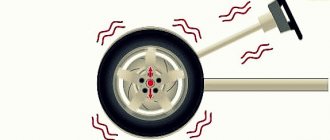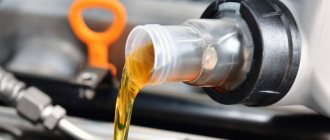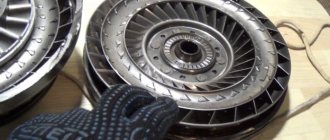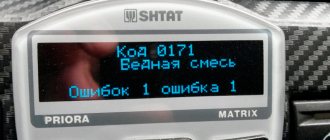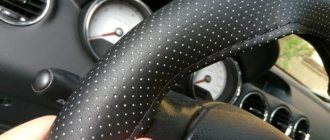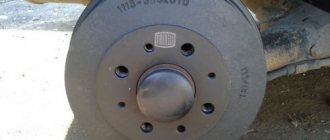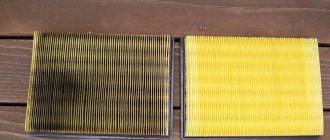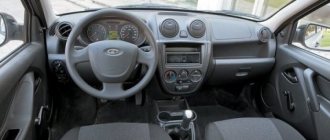Reliable and effective brake operation is one of the key components of safe driving. Therefore, the car owner’s task is to constantly monitor the behavior of the car when braking, when the corresponding pedal is pressed to the floor, and gradually the car begins to stop.
Under normal vehicle conditions, acceleration and braking should not be accompanied by any additional sensations on the steering wheel. But it happens that when you press the brake, the driver feels vibrations that are transmitted to the steering wheel and manifest themselves as a beat.
This is an uncharacteristic symptom for a working machine. Be sure to check all potential suspects, diagnose them, and make repairs as needed. You can troubleshoot some problems yourself. To solve other problems, it is better to seek qualified help.
Main reasons
Experts identify several main reasons why a car hits the steering wheel when braking. And there are appropriate ways to solve these problems.
Here it is worth focusing attention on such points.
- New low quality parts. Think and remember why similar manifestations on the steering wheel occurred. It is possible that vibrations appeared precisely after the repairs were carried out, when brake discs and pads were changed, or interference was made in the design of the chassis and suspension elements. If vibrations become noticeable just after the repair, then newly installed parts become potential suspects. They may be of low quality, a factory defect, or simply not suitable for your car.
- Low level of qualification of the master. This is not exactly the reason, but it also needs to be taken into account. Insufficient experience of the repairman who carried out the repair can provoke similar symptoms on the car. The technology was broken, and therefore now, until the problem is eliminated, the symptoms will not go away.
- Brake discs. Also, the reasons may lie in driving through cold puddles or snow. If you notice that the steering wheel shakes when braking after this, it appeared precisely after traveling, check the condition of the brake discs. When faced with sudden temperature changes, becoming very hot and then immediately cooling, the discs can become deformed.
- Also, a malfunction of the brake discs is indicated by vibration with a large amplitude and a feeling that the steering wheel has become more difficult to hold. Here the reason may lie in the brake discs themselves, or in incorrectly performed bleeding of the brakes after repair or service.
- Problems with the chassis. This is why the steering wheel potentially shakes even when braking. You will need to diagnose the chassis and try to detect the faulty component.
- Hernia and deformation of the wheel. Sometimes this is not so easy to notice if the change in wheel geometry is minor. But if it is present, it will be reflected in the behavior of the car during acceleration and braking.
- Wheel nuts. The reason is banal. These are poorly tightened fasteners. They are often advised to be checked first. The cause often goes unnoticed, and drivers spend a lot of money and time on diagnosis.
There are more than enough potential reasons. And each of them can potentially create serious problems for the car owner.
If you notice the first signs of vibrations in the steering wheel, be sure to go to the garage for independent diagnostics and repairs, or contact a car service center for help.
It is strictly not recommended to delay repairs if such symptoms occur.
Next, it is worth considering separately the most common causes of steering wheel vibrations during braking.
What to do if the steering wheel shakes when braking
How to change engine oil and filter in a car
After 10,000 - 15,000 km, car manufacturers recommend changing the engine oil and filter to improve engine performance and preserve its service life. This procedure can be carried out either at a service station, where special equipment is installed, including an oil dispenser that measures the level of lubricant in the tank, or independently. But before getting down to business, it is important to familiarize yourself with the mechanism of this procedure and learn how to carry it out correctly. Tool kit To change the engine oil and filter, the following tools and materials are required: • engine oil; • oil filter; • socket wrench; • wrench for oil filters; • container for draining old oil; • funnel; • paper towels. Particular attention should be paid to the choice of engine oil. It must match the car brand and its technical characteristics, otherwise you risk purchasing a product that will cause engine malfunction. Algorithm of actions After all the attributes are prepared, proceed to the main part - replacing the engine oil and oil filter. Step 1: draining the old oil The first thing you need to do is warm up the car: start the engine for 1-2 minutes, then drive for a few kilometers at low speeds and return to the service station. The fact is that heated oil drains more easily. Stop the car on a level surface and start draining the old oil. To do this, you need to lay out paper towels, place a tray on them in the place where the crankcase is located, and, opening the drain plug using a socket wrench, wait until the lubricant has completely drained out. Next, install the drain plug back. Step 2: Filter Replacement Once you have changed the oil, proceed to remove the oil filter using a wrench. Before installing the new filter, apply a couple of drops of lubricant to the rubber gasket to soften it a little and ensure a tight fit to the hole. It is better to screw in the new filter by hand. Step 3: fill the engine oil Now fill the reservoir with a “fresh” portion of engine oil. To do this, you need to unscrew the cap on the oil filler neck, install a funnel on the hole and fill in the lubricant. After this, screw on the cap and start the engine. It should run for a couple of minutes to establish oil circulation in the engine. Step 4: check the oil level This is the most critical stage, since the engine operation and the life of the vehicle depend on the level of lubricant. You need to turn off the engine, wipe the dipstick dry and immerse it in a container. Once you are sure that the fluid level is optimal, you can complete the procedure. If there is not enough engine oil in the reservoir, it needs to be topped up, and if there is too much, it is better to carefully drain it, repeating the procedure. At a service station, an oil dispensing column is used to measure the oil in the tank. Thanks to this device, time and effort are saved, and changing the oil and oil filter is quick, accurate and high-quality. Step 5: Dispose of waste After you have changed the engine oil, remove the paper towels, pour the old oil into a canister, and place the filter in a plastic bag. “Waste” can be taken to a service station. Be sure to write down the date you changed the oil and the number of kilometers recorded on the odometer. Change the engine oil at a car service after 10,000 - 15,000 km to ensure trouble-free operation of the engine and vehicle for a long period of time. Author: Dmitry GotovchikView news
Brake system elements
To cope with steering wheel beating when braking, you need to diagnose the malfunction. If you notice that vibrations are transmitted only to the steering wheel, there is a high probability of malfunctions on the part of the brake system or specifically on the front brake discs.
If at the same time the brake pedal also vibrates when pressed, the rear brakes are also suspect.
- To diagnose the problem, apply the parking brake. If the vibration goes away when you turn it on, then the problem is 99% only in the front part of the brake assembly.
- If the beating continues, then it makes sense to diagnose the rear brake discs or drums, and other elements of the brake assembly (pads, calipers, etc.).
- Visually check for deformed and damaged parts.
- Check the condition of the wheels themselves, tires and discs, and externally inspect the brake discs.
- Raise the car using a jack or lift, turn off the gear on the box.
- If the suspect is the rear brake assembly, disengage the handles and spin the wheel. If the rotation is uneven and the intensity changes, that is the problem.
Even a visual inspection can often provide an answer to the causes of vibrations. If there are chips, cracks and other signs of deformation, the problem can be solved by grooving. But this is not always possible with severe wear. Then just replace.
If the brake disc takes on a bluish tint, this indicates severe overheating.
The least likely cause is the brake calipers. They rarely cause beating or vibration. But if the other suspects are ruled out, check the calipers. Replace if necessary.
How to solve the problem with vibrations in the steering wheel?
When brake discs wear out, there are 2 ways to solve the problem. Grooving and replacement. By changing an element of the system, you can forget about the steering wheel beating for a long time. Grooving allows you to get rid of vibrations and keep your budget safe. But the working life of the disk will decrease and a repeat procedure may soon be required.
It is recommended to replace on both sides at the same time. This way you will achieve the best effect and eliminate steering wheel beating.
Deformation of the steering rod, ends, brake calipers - replacement of the part that has become unusable is mandatory. Actions to give the spare part its original technical characteristics are doomed to failure. The effectiveness of such measures is extremely low.
In situations with tire damage, everything depends on the degree of wear and experience of the technician. Often the problem is resolved quickly and without undue burden on the budget.
Chassis components
If, after checking, the vibration on the steering wheel during braking does not go away, you should move on to other potential suspects. These include the chassis of the car.
When it is determined that the causes of vibrations come from the front end, but no problems have been identified in the brake assembly, examine the condition of the chassis. Most often, if the steering wheel shakes when you press the brakes in a car, the culprits are the tie rods and tie rod ends.
In the absence of the necessary experience, it is quite difficult to diagnose such a malfunction in the form of deformation of these elements. Take a closer look, perhaps you will see uncharacteristic changes in geometry, some bends. Sometimes it is necessary to carry out diagnostics of the entire chassis.
The elements of the chassis also include wheels. If you notice a hernia or deformation in the tires, and at the same time the steering wheel hits hard directly when braking, you should simply change the tires. In some cases, damage is observed on the inside. Here you will have to disassemble and examine the condition of the tires from the inside.
Diagnostics
“Why does the steering wheel shake when braking?” — this question should first be asked to a car service mechanic. According to the traffic rules, it is prohibited to drive onto public roads with a faulty steering brake system. Of course, you can examine your car yourself or entrust this to a “specialist” in a garage cooperative. But after that, it’s still worth sending it to a professional for diagnostics. The most reliable option is a warranty workshop. This is especially important if the car was purchased recently. If the car is used, then at the local auto forum the regulars will suggest a mechanic you can trust. But be careful, you can end up with expensive repairs if you encounter a scammer.
Remember, the sooner you diagnose the problem and go for repairs, the cheaper it will cost you.
Before diagnostics, you should drive on a deserted highway at different speed ranges - slow, medium, fast. Determine whether the steering wheel shakes when braking or accelerating. At what speeds does the beat appear, at which it becomes greater, at which it disappears. Does the vibration depend on smooth acceleration and braking or only on sharp ones?
Troubleshooting Methods
When the steering wheel of a car constantly shakes when the driver presses the brake, you cannot put up with this state of affairs. The problem should be resolved as soon as possible.
The actions of the motorist largely depend on what kind of malfunction we are talking about.
- If the brake discs or drums are worn out, the problem can potentially be solved in 2 ways. This is the replacement of worn elements, or their grooving. If you make a replacement, the beating will go away for a long time. Grooving is a temporary measure, but it can save you money. The effectiveness and longevity of brakes after grinding is very unpredictable. Much depends on the condition of the knot and the skill of the one who will sharpen them.
- When replacing brake system elements, especially drums, discs and pads, it is recommended to install new elements simultaneously on both sides of the front or rear axle. That is, when the rear left brake disc is replaced, a new rear right disc must be installed in parallel. The state of the second does not matter.
- In case of damage to the calipers, steering rods and tie rod ends, only replacement helps. These elements cannot be repaired or restored. Any attempt at restoration can result in serious consequences.
- Damage to tires and wheels can be eliminated by replacing or restoring them. Much depends on the level of deformation and complexity of the restoration.
Whenever possible, try to replace parts rather than rebuild them. Restoration gives only a temporary effect, and the car’s behavior becomes more unpredictable.
Many people underestimate the danger of vibrations on the steering wheel when braking. And this is a very common mistake.
Other causes of vibration
Steering wheel vibrations that are not associated with the car jerking in different directions appear for the following reasons:
- One of the vehicle's process fluids, for example, transmission oil, got on the pads as a result of oil seal wear. Possessing significant viscosity, the lubricant adheres well to any surface and disrupts the normal operation of the brakes when the pedal is pressed sharply.
- The internal elements of the steering rack have worn out, and significant play has appeared.
- The steering rod ball pins have become unusable.
- Inoperability of shock absorbers and front struts. Vibration on the steering wheel is felt when braking sharply and at the same time entering a turn.
Note. Problems associated with wear of ball joints and shock absorbers also appear on the wheels of the rear axle. Most often, brake fluid gets on the pads, the reasons are faulty working cylinders and leaky rubber cuffs.
A strong side impact of any wheel on a high curb (for example, due to ice or an accident) can lead to deformation and subsequent vibration. The main load is taken by the disk, wheel bearing and various suspension joints. Any of the listed parts can become cracked and cause the steering wheel to vibrate during braking.
Diagnostic stages
Lada 2107 Logbook Body repair VAZ 2107 Part 1
You need to understand that often, if a car pulls to the right, then the problem in the brakes should be looked for on the left, and if it pulls to the left, vice versa. But in rare cases this is not always the case. We'll talk about this below.
Regardless of what you drive, a Renault Logan, VAZ 2107, VAZ 2114 or another car, as well as the types of brakes installed (disc and drum), the reasons for the car pulling to the side when braking are usually the same.
The first thing you need to pay attention to:
- Air in the brake system;
- The operation of the calipers and the condition of their elements (boots, guide pin, etc.) - touch how hot the caliper is, perhaps it is jammed;
- Operation of working cylinders;
- Oil or other technical fluids getting on brake pads and discs.
Possible solutions
Once you have decided on the possible options for why the steering wheel shakes when braking, you need to think about the best solution to the problem.
If the cause is discs, drums or pads, these mechanisms should be replaced immediately. Operating the vehicle is not recommended until the repair is completed.
If the diagnostics revealed backlashes and gaps in the steering rod, they must be eliminated in a timely manner.
A worn ball joint requires immediate replacement. Otherwise, this may lead to her vomiting the first time she falls into a large hole, of which we have plenty on our roads. Operating the car before replacement is also highly undesirable.
If the balance is disturbed, it is worth visiting a tire workshop. Don't forget that all four wheels need to be balanced at once.
If possible, dirt should be washed off with a strong jet or cleaned mechanically. You should not be too zealous so as not to accidentally damage other units.
Loose bolts and nuts must be checked promptly and tightened as necessary. After fitting the tires, always check the tightness of the tires yourself. Remember that the nuts should also not be tightened too tightly to avoid deformation of the wheel rim.
Try to choose repair centers equipped with a torque wrench.
Loose bolts and nuts
“The steering wheel shakes when braking. VAZ 2110,” is a phrase that a mechanic at a service station can often hear. First of all, of course, he will check how tightly the bolts are tightened. The source of the problem is obvious and extremely simple. But at the same time one of the most dangerous. If you “forgot” to tighten the nuts while working at a tire shop, the wheel may “fall off” during one of the maneuvers, which can lead to serious injuries. Over-tightened bolts can deform the wheel rim, which can also cause it to vibrate.
Loose nuts, in addition to the wheel flying off, can cause serious repairs to wheel and brake discs, pads, and hubs. Bolts, cotter pins, and mounting holes in disks are also damaged.
Personally control the tightening of the bolts, which will help avoid many problems in the future.

